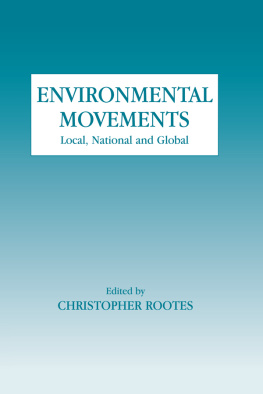The publisher gratefully acknowledges the generous support of the Art Endowment Fund of the University of California Press Foundation, which was established by a major gift from the Ahmanson Foundation.
The publisher also gratefully acknowledges the generous support of the Richard and Harriett Gold Endowment Fund in Arts and Humanities of the University of California Press Foundation.
University of California Press, one of the most distinguished university presses in the United States, enriches lives around the world by advancing scholarship in the humanities, social sciences, and natural sciences. Its activities are supported by the UC Press Foundation and by philanthropic contributions from individuals and institutions. For more information, visit www.ucpress.edu.
University of California Press, Ltd.
London, England
Online Auxiliaries for
Instructors and Students
TEACHING GUIDES: Author's website (www.lindaweintraub.com/tolife)
Studio Art Level 1 ECO ART GENRES
Art projects introduce bio art, digital art, installation, public art, social practice. Sample syllabus.
Studio Art Level 2 ART STRATEGIES
Art projects explore eco art visualization, intervention, activation, satirization. Sample syllabus.
Contemporary Art History
Assignments contextualize contemporary eco art within the history of art. Sample syllabus.
Environmental Studies Level 1 ECO ART ISSUES
Projects address energy, waste, climate change, habitat, sustainability. Sample syllabus.
Environmental Studies Level 2 ECO APPROACHES
Projects explore conservation, preservation, urban ecology, restoration ecology, deep ecology. Sample syllabus.
STUDENT RESOURCES: Authors website (www.lindaweintraub.com/tolife)
a. Color images of works discussed in the book.
b. LINKS to videos and artist interviews
c. Blog updating artists careers and the themes they address.
Acknowledgments
Tradition tampering , replete in this book, is not confined to the remarkable achievements of contemporary eco artists. It has even infiltrated the Acknowledgments, a standard component of every published text. The word acknowledgment is objectionable because it is too formal. It seems appropriate for legal documents and official issues of rights and claims, but it does not convey my heartfelt appreciation to the following supporters and participants. I am eager to convey the gratitude, as well as the affection, they have earned.
The artists, first and foremost, are the reason why I describe the arduous task of compiling this volume as a privilege. Besides honoring the brilliance of their creative endeavors, it is my hope that this book will assist them in fulfilling their missions to awaken eco consciousness, conscience, and consideration.
Rose Robitaille was hired to deal with photo rights and reproduction. She far exceeded her job description by supporting the long and convoluted process of preparing the manuscript. While I am particularly thankful to her for providing the first edit of the text, it is her gracious enthusiasm and persistence that deserve special recognition.
Kari Dahlgren replaced Deborah Kirshman as the books editor at the University of California Press. Both guided the texts formulation and public presentation. Since this process transpired over multiple years, there was ample opportunity to benefit from their astute supervision and enjoy their generous support.
Dan Franck graced this project with the experience he accumulated over the course of twenty years in educational publishing, science curriculum development, and science content writing. His editing contributions are apparent throughout the text. I am pleased that his generosity has been returned to his alma mater. Dan earned his doctorate in botany at the University of California, Berkeley, the publisher of this volume.
Andrew Weintraub served as a daily sounding board, consultant, counselor, and proponent of this authors efforts. He added much-appreciated affection to his performance in all these roles.
Skip Schuckmanns multiyear tutoring embraced cosmological theories, the minute operations of microclimates, and the wondrous adventures of life on Earth that exist between these extremes.
David Peattie, owner of BookMatters, and copyeditor Lou Doucette joined UC Press marketing manager Lindsie Bear, associate editor Eric Schmidt, and designer Nicole Hayward to benefit this project with their best work. Heidi Neff, Susan Steinman, Laurie Seeman, Dean Drake, and Alex Tuller all contributed to the refinement of the text and its expansion into computer space. I am grateful to them all.
Preface
Is that all? were the words that led to the writing of this text. They were uttered by Skip Schuckmann, a near-stranger at the time, when I told him I had just acquired raw land in the Hudson Valley, New York, and planned to live there the rest of my life. I described the rolling hills, wildflower meadow, forest stream, and a view of the Catskill Mountains to the west. My description culminated in an exuberant, Its so beautiful! His question triggered a journey of discovery that ultimately led me to refashion my personal lifestyle and redirect my professional pursuits. Both morphed as I discovered that beauty was not all the site afforded. Its visual qualities were gradually enhanced by previously unrecognized assets. Its botanical and zoological populations, for example, performed wondrous feats of resilience and set exemplary standards of resourcefulness. Over time, the resources that sustain these species have sustained me and my family. At first, we harvested the stone, moss, berries, acorns, deer that were available for harvesting. Then, optimizing the productivity of this habitat became my life mission. I am diligently transforming our eleven acres according to permaculture principles. Water management, soil creation, food production, animal husbandry, forest gardens, composting, fencing, terracing, and winter gardening are hands-on primers in ecology and joy. Over time, I directed this newly acquired appreciation of the hypersensitivity of ecosystems to my profession by founding Artnow Publications. The eco art textlets it publishes are produced according to stringent environmental principles.
The thesis and format of the book you are reading are also products of the question, Is that all? When I applied that inquiry to the question, Why write an eco art textbook?, compelling reasons proliferated. They, too, exceeded honoring the beauty that graces our fair planet. Five persuasive answers supplemented the Earths immense storehouse of visual pleasures. Why write an eco art textbook?
















